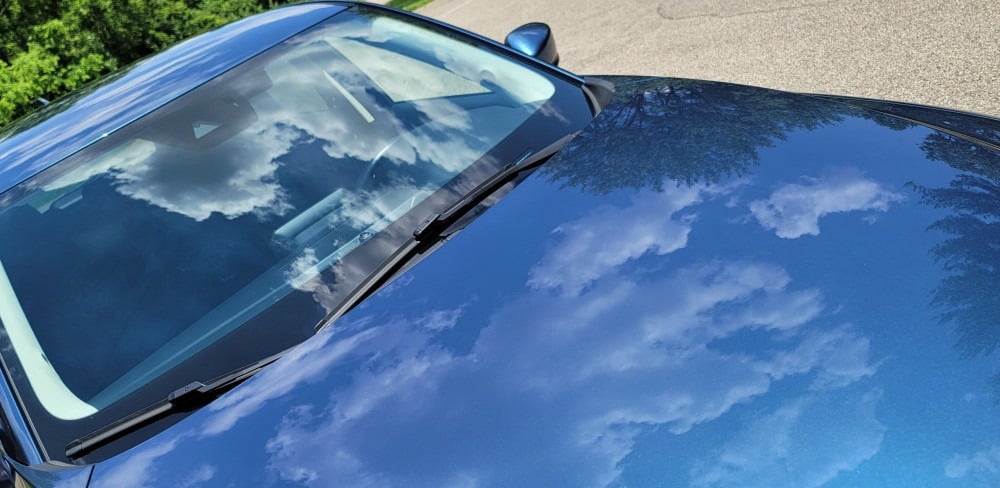Last updated on February 26th, 2024
In my last post, I discussed Top Car Wash Tips for a Flawless Finish! Since you finished properly washing the car, now is time to apply quality wax to the surface to protect it. This post will discuss the Ultimate Guide: Get Showroom Shine with Car Waxing.
Why should you wax your car?
Regularly waxing your car helps protect the clear coat painted surface. When you wax correctly, your vehicle will exhibit a new car showroom shine.
Many modern vehicles often have a few coats of paint and primer. The topmost layer is the clear coat of paint. The next layer is the base color paint, with a primer or base coat.
Interestingly, clear coat paint was first used on new cars in the late 1970s. Before the late 70s, cars were painted with a single layer of enamel paint that was not durable and easily chipped & faded.
Waxing your vehicle adds protection to the top layer or the clear coat. It also creates that deep, shiny surface best illustrated in the picture above. The wax will help to preserve the clear coat and protect against elements.
These elements include UV rays, bird dirt, tree sap, snow, rain, road salt, and other contaminants. Waxing your car should protect all of the surface layers from fading.
If you do not wax your vehicle, the topcoat or clear coat could become damaged. You might expect to see fading, chipping, peeling, or flaking in your paint.
How often should you wax your car?
Unfortunately, no predetermined or steadfast rule exists for how often you should wax your car for that showroom shine. A good rule of thumb is to wax it once the water stops beading or sheeting off your vehicle.
I best illustrated it in the image below. I mentioned in an earlier article I have lived in Southwestern Ohio for a long time, and we are exposed to all four seasons. Some seasons here can be extremely harsh on a vehicle’s finish.
I wax my car at least once annually, but this is not a rule. I might wax bi-annually based on the seasons or other weather and environmental variables. One important thing to remember is that waxing a car protects the finish.

Affiliate Marketing Disclaimer: I am an affiliate marketer with links to online retailers on my website. When people read what I have written about a particular product, click on those links, and buy something from those links, I earn a small commission from the retailer at no extra cost to the buyer.
Different waxes provide differing levels of defense.
Depending on the type of wax you use will determine how often you will need to wax your vehicle. Different wax products from various manufacturers will have diverse formulations, and each will perform with mixed results.
I have used many consumer-grade wax products on the market, and I like to use a product from the Chemical Guys called Jetseal.
I recently waxed my car with Jetseal and will report my findings in a future article. It was simple to apply. After twenty minutes for the product to dry to a haze on the surface, I buffed it off with one of my machine polishers with a microfiber bonnet. If you are unfamiliar with a machine polisher, you can buff the dried, polished surface with dry microfiber towels.
Types of Wax and Sealant:
- Paste Wax – One of the original forms of wax, easy to apply, must be spread on dry surfaces, has a thicker consistency, takes longer to put on, and typically lasts three to six months before reapplication is required.
- Liquid Wax – Synthetic Polymer formulation combined with natural wax that offers defense against UV rays and is easier to apply in thinner layers but does not last as long before reapplication (usually eight weeks) is required.
- Spray Liquid Polymer – Derived from manufactured chemicals, it has the same formulations as wax, is considered synthetic wax, often does not provide the same level of shine, and needs to be reapplied every three to four months.
- Sealant – Full synthetic formula, protects the exterior paint, provides a glossy shine, has been known to shield the surface from water spots, is easy to use, and applications can last six to twelve months. It can be topped with your favorite wax.
How should you apply wax or sealant to your vehicle?
You should always follow the directions on the label because applying the chemicals to any part of your car is essential. If you want to extend the wax’s life, use a paint sealant and apply your favorite wax product afterward.
The recommendations for wax or sealant include shaking the product’s container well (unless it is a paste wax), storage temperatures, and times for application or reapplication. The labels indicate how much product you should apply, the materials needed to use the product, and climate or weather conditions.
Working in small cross-hatching sections, such as two-foot squares, is best. I prefer to use light pressure and side-to-side motions to put the product on with a circular buffing motion with a quality, edgeless microfiber towel to remove the product from my vehicle’s surface. You must apply the wax or sealant evenly as you move to different sections of your car. The ultimate guide: get showroom shine with car waxing.
How to use a dual-action polisher to seal or wax a car?
If you are like me and want to speed up sealing or waxing your car, you can use a dual-action machine buffer to perform the job.
If you are going this route, you must be careful and familiarize yourself with the machine. You use the device on the slowest settings and with a soft sponge pad when spreading the product in your two-foot square surface areas. I still recommend removing the product from the surface with a quality microfiber towel by hand. After familiarizing yourself with a wax or sealant product and the machine, use a DA orbital polisher on the lowest setting with a high pile microfiber polish removal pad. (Always use extreme caution in these circumstances).
Conclusion and disclaimer
Before using a machine polisher, you should be able to familiarize yourself with all of the warnings and instructions provided on the product label and documentation. Also, please familiarize yourself with all product labels when working on your car.
If you enjoyed the Ultimate Guide: Get Showroom Shine with Car Waxing, please include your comments and questions below in the comment section. I will be happy to respond to you. Thank you for visiting my site, and please come back for future posts.


